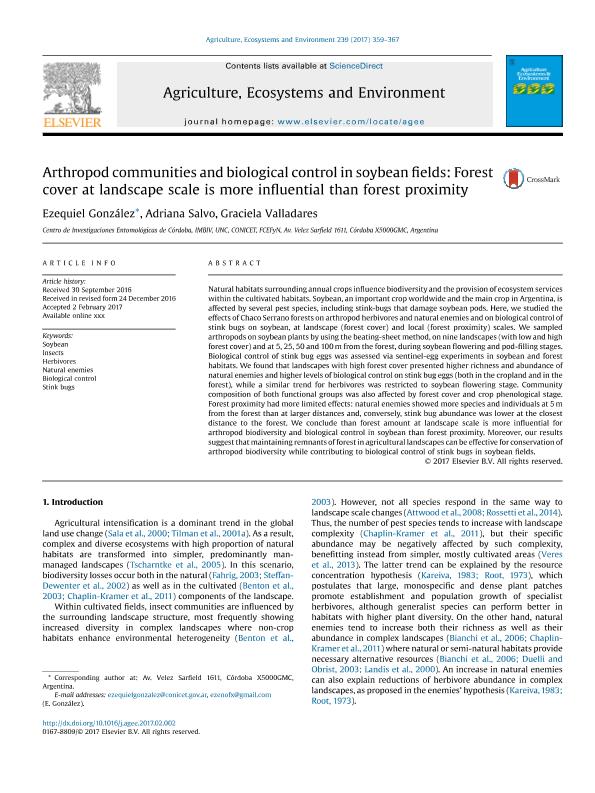Mostrar el registro sencillo del ítem
dc.contributor.author
González, Ezequiel

dc.contributor.author
Salvo, Silvia Adriana

dc.contributor.author
Valladares, Graciela Rosa

dc.date.available
2017-07-11T16:15:34Z
dc.date.issued
2017-02-15
dc.identifier.citation
González, Ezequiel; Salvo, Silvia Adriana; Valladares, Graciela Rosa; Arthropod communities and biological control in soybean fields: Forest cover at landscape scale is more influential than forest proximity; Elsevier Science; Agriculture, Ecosystems and Environment; 239; 15-2-2017; 359-367
dc.identifier.issn
0167-8809
dc.identifier.uri
http://hdl.handle.net/11336/20116
dc.description.abstract
Natural habitats surrounding annual crops influence biodiversity and the provision of ecosystem services within the cultivated habitats. Soybean, an important crop worldwide and the main crop in Argentina, is affected by several pest species, including stink-bugs that damage soybean pods. Here, we studied the effects of Chaco Serrano forests on arthropod herbivores and natural enemies and on biological control of stink bugs on soybean, at landscape (forest cover) and local (forest proximity) scales. We sampled arthropods on soybean plants by using the beating-sheet method, on nine landscapes (with low and high forest cover) and at 5, 25, 50 and 100m from the forest, during soybean flowering and pod-filling stages. Biological control of stink bug eggs was assessed via sentinel-egg experiments in soybean and forest habitats. We found that landscapes with high forest cover presented higher richness and abundance of natural enemies and higher levels of biological control on stink bug eggs (both in the cropland and in the forest), while a similar trend for herbivores was restricted to soybean flowering stage. Community composition of both functional groups was also affected by forest cover and crop phenological stage. Forest proximity had more limited effects: natural enemies showed more species and individuals at 5m from the forest than at larger distances and, conversely, stink bug abundance was lower at the closest distance to the forest. We conclude than forest amount at landscape scale is more influential for arthropod biodiversity and biological control in soybean than forest proximity. Moreover, these results suggest that maintaining remnants of forest in these agricultural landscapes can be effective for conservation of arthropod biodiversity while contributing to biological control of stink bugs in soybean fields.
dc.format
application/pdf
dc.language.iso
eng
dc.publisher
Elsevier Science

dc.rights
info:eu-repo/semantics/openAccess
dc.rights.uri
https://creativecommons.org/licenses/by-nc-nd/2.5/ar/
dc.subject
Soybean
dc.subject
Insects
dc.subject
Herbivores
dc.subject
Natural Enemies
dc.subject
Biological Control
dc.subject
Stink Bugs
dc.subject.classification
Conservación de la Biodiversidad

dc.subject.classification
Ciencias Biológicas

dc.subject.classification
CIENCIAS NATURALES Y EXACTAS

dc.subject.classification
Ecología

dc.subject.classification
Ciencias Biológicas

dc.subject.classification
CIENCIAS NATURALES Y EXACTAS

dc.subject.classification
Otras Ciencias Agrícolas

dc.subject.classification
Otras Ciencias Agrícolas

dc.subject.classification
CIENCIAS AGRÍCOLAS

dc.title
Arthropod communities and biological control in soybean fields: Forest cover at landscape scale is more influential than forest proximity
dc.type
info:eu-repo/semantics/article
dc.type
info:ar-repo/semantics/artículo
dc.type
info:eu-repo/semantics/publishedVersion
dc.date.updated
2017-07-07T20:06:52Z
dc.journal.volume
239
dc.journal.pagination
359-367
dc.journal.pais
Países Bajos

dc.journal.ciudad
Amsterdam
dc.description.fil
Fil: González, Ezequiel. Consejo Nacional de Investigaciones Científicas y Técnicas. Centro Científico Tecnológico Conicet - Córdoba. Instituto Multidisciplinario de Biología Vegetal. Universidad Nacional de Córdoba. Facultad de Ciencias Exactas Físicas y Naturales. Instituto Multidisciplinario de Biología Vegetal; Argentina
dc.description.fil
Fil: Salvo, Silvia Adriana. Consejo Nacional de Investigaciones Científicas y Técnicas. Centro Científico Tecnológico Conicet - Córdoba. Instituto Multidisciplinario de Biología Vegetal. Universidad Nacional de Córdoba. Facultad de Ciencias Exactas Físicas y Naturales. Instituto Multidisciplinario de Biología Vegetal; Argentina
dc.description.fil
Fil: Valladares, Graciela Rosa. Consejo Nacional de Investigaciones Científicas y Técnicas. Centro Científico Tecnológico Conicet - Córdoba. Instituto Multidisciplinario de Biología Vegetal. Universidad Nacional de Córdoba. Facultad de Ciencias Exactas Físicas y Naturales. Instituto Multidisciplinario de Biología Vegetal; Argentina
dc.journal.title
Agriculture, Ecosystems and Environment

dc.relation.alternativeid
info:eu-repo/semantics/altIdentifier/url/http://www.sciencedirect.com/science/article/pii/S0167880917300658
dc.relation.alternativeid
info:eu-repo/semantics/altIdentifier/doi/http://dx.doi.org/10.1016/j.agee.2017.02.002
Archivos asociados
